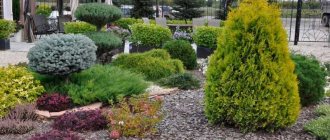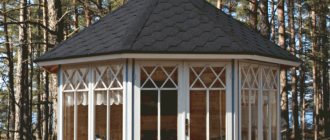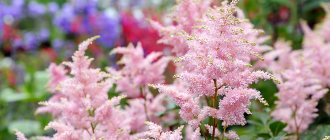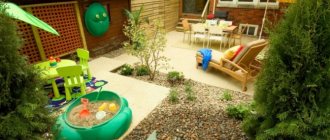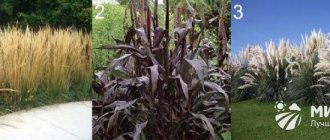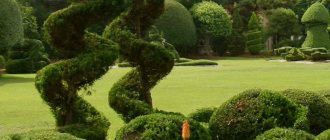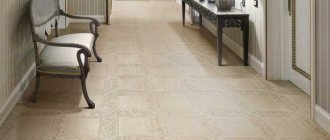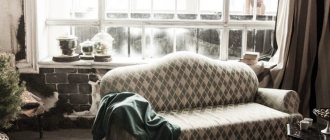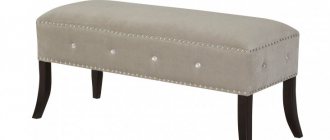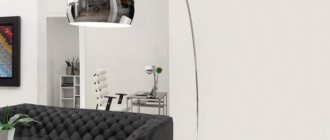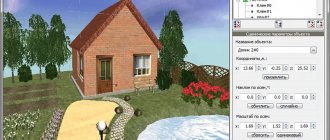Coniferous plants are often indispensable for landscape design. An easy-to-maintain green garden decoration will look great all year round and purify the air. Compositions from coniferous plants are easy to combine with other elements; you can add shrubs, stones and even flowers.
Despite the fact that in nature we have only a few species of conifers, due to introduced species, and even more due to the selection of ornamental varieties, the market offers a choice of hundreds of plants that are resistant to our climate. Therefore, everyone, if desired, can create a corner of harmony on their site to their own taste.
Secrets of creating perfect compositions
Conifers in the landscape design of small areas are often chosen among dwarf varieties. Small plants are compact and do not clutter up the area, but they grow more slowly and therefore may command higher prices. Before buying plants, it is better to draw up a sketch in advance or order a project from us, calculate the required number of plants of each variety, taking into account the available area and the size of adult plants, prepare places for planting, and only then go to the garden center or nursery.
During landscape design, do not forget about the spatial composition; try to make sure that all the elements of coniferous and deciduous plants are combined in size and shape, and do not contradict the surrounding space. It is always easier, cheaper and better to follow existing natural conditions than to try to radically change them. If the neighboring forest grows mainly pine trees, then on your site, most likely, there will also be suitable conditions for them.
Not the last place when drawing up a plan should be occupied by the color scheme - many conifers used in landscape design differ significantly in tone. The palette is varied - there are plants of pale light green, rich green, yellow, blue and other colors. At the same time, the color of the plant changes with the season. Young growths usually look the brightest. If you are thinking over a composition that will include three elements, use no more than two colors. The maximum for a composition of five elements is three colors. In the case of large-scale projects using different breeds over large areas, it is better to separate groups by color to avoid disharmonious combinations.
Harmonious color combination
Much depends on your goals. If the task is simply to decorate the area and try your hand at a new business, then it is better to start with a small project - for example, a flower bed or an alpine slide. Many gardeners choose coniferous trees to create a hedge to separate the area from the neighboring area, extraneous sounds and dust. This way you can zone the space - for example, fence off a utility area or create a garden room. To replace the classic yew hedge, they use common spruce - a very popular option in Scandinavia and Finland, less often other types of spruce - Serbian, prickly. Western thuja hedges are very popular. It grows quickly and lends itself well to molding. Less commonly, hedges are grown from pine trees or junipers.
Coniferous hedge. Serbian spruce, then larch. In the foreground is the mountain pine “Pumilio”.
Creating a landscape design from coniferous plants with your own hands is a difficult but exciting task for beginners. Therefore, if you decide to try, then first study as much material as possible on this topic. Pay attention to one common mistake when conifers are called conifers. Conifers can probably be used in landscape design; but we would not recommend doing this, since growing conifers may fall under an article of the criminal code. Ephedra is a foliage narcotic plant. Don't confuse it with spruce ;)
Spruce by the pond
If you have a pond on your property, complete it with a stone frame, and plant several Glaucian firs around it in combination with perennial herbaceous plants and variegated flowers.
You should not place thuja and fruit and berry crops next to this spruce: they are incompatible.
Gray spruce, or Glauka (Picea glauca) grows up to 2.5 m in height in 10 years. The tree has a dense conical crown and hard, needle-like needles of a silver-blue color. Glauka spruce is one of the most popular trees used in landscape design due to its unpretentiousness. It will become the “highlight” of any landscape ensemble in the garden.
Alpine slide
The Alpine slide is created according to the same principle - creating an imitation of the wild nature of the Alpine belt. Keeping the previous principle in mind, you can combine coniferous compositions in landscape design with other plants and stones. It is important not to fall into typical mistakes described in English literature of the 19th century, and not inadvertently make a “dog’s grave” or “raisin bun”.
Miniature alpine slide - rock garden in a stone trough (miniature rolling pin)
Try choosing a cascading structure to add a special charm to the area. It is important to arrange the parts so that large elements do not block smaller ones.
Selection of plants for a coniferous composition
When you see a coniferous garden in a photo, it seems that creating your own composition will not be difficult, but the first problems arise almost immediately - when choosing plants.
Choosing conifers is not an easy task
In a small garden, you should not use seedlings of wild spruce and pine trees - it will be difficult to keep them compact, and they will quickly reach their characteristic height and diameter, taking up almost the entire space on the site.
Choose compact plants that have been specifically bred for landscape design, because their growth is not as active and will not negatively affect the composition in the future. This will require special literature and catalogs published by large nurseries or industry associations. The most complete catalog in Russia is published by the Association of Planting Material Producers of Russia, APPM.
Choosing the right plants is the key to success
All conifers can be divided into three groups depending on size:
- Tall growing . This group includes prickly spruce, which can reach 40 meters in height, Serbian spruce with a narrow crown, prickly spruce, including the blue form, Scots pine, Siberian pine (cedar), and pseudohemlock.
- Medium growing . Western thuja and its varieties “Brabant”, “Smaragd” and others, Scots pine “Norske Type”, mountain pine, columnar juniper, some varieties of prickly spruce.
- Undersized . An array of mountain pine “Pumilio”, common spruce “Nidiformis” (nest-shaped form), common juniper “Repanda” (creeping form pressed to the ground), horizontal juniper, microbiota (“Russian cypress” native to the Far East) can look impressive on the site. .
Subtleties of planting and care
Before planting a tree or shrub, consider that it will need more space in the future, so leave room to spare based on the size of the mature plant. If the diameter of an adult shrub is, for example, three meters, then this is the minimum area that must be allocated for this variety . Several smaller seedlings can be planted in this area, which will quickly close their crowns and cover the ground.
It is important to leave enough space for conifers to grow. The planting density and size of the clumps is determined both by the dimensions of adult plants and the size of seedlings.
Most species require minimal care - systematic watering in the initial period and during drought, weeding, the soil must be loosened and fertilized in a timely manner. You can pinch young shoots to form a crown.
Follow simple but important rules:
- Under no circumstances should the root collar be allowed to go deep. It is necessary to check whether it is buried during the packaging of the plant in the nursery. You need to find the main, skeletal thick roots. The top of the roots extending from the trunk, like the spokes of a wheel, should be located at the level of the top of the soil.
- Mulch the plantings with crushed bark, wood chips or pine needles 4–5 cm thick, without covering the root collar.
- When you combine tall and short plants, achieving harmony can be difficult. To avoid a feeling of clutter, do not choose plants of many types and colors. It is better to use one or two species, or varieties, but in large quantities, than to plant the entire range of the garden center on the site.
- Try playing with geometry by combining different shapes - for example, spherical and pyramidal plants.
The ideal time for planting is spring after the soil has thawed or from late summer to early autumn. In mid-summer you can plant conifers on the site, but it is better to avoid hot periods. It is better to mark planting sites in advance using pebbles or pegs. In this case, it is important to prepare the planting holes and soil - mix the soil with peat and sand. The recipe for the soil mixture depends on the available soil; you can dilute it with sand and peat.
Most conifers prefer well-drained soils, so in areas with heavy, clayey soils you will have to make large planting holes with lighter soil and lay drainage for the bases of the planting holes and pit, leading it into a drainage system or ditch.
Look at the trees growing naturally on and near your property. If these are pine trees, then the soils are most often sandy and light; Spruce trees tolerate dry soil less well.
Newly planted dwarf cedar (Pine pine) and Scots pine (in the background).
When planting a plant with a clod of soil in burlap and netting, after placing the seedling in place in the hole, cut the top of the netting and untie the burlap, find the main roots and make sure that the root collar is not buried. After this, remove the mesh from the top of the ball, fill it with soil around the ball, and spill it with water. Add soil again and compact it with your foot.
When planting a plant from a container, also make sure that the root collar is not buried and that the roots are not curled. If necessary, remove the soil to the level of the root collar, and all small roots that may have grown around the trunk above the main roots. Roots tightly twisted along the walls of the container are a defect; it is better not to take such plants; but cut the top layer with a sharp knife in four to five places, vertically.
After planting, it is better to mulch the tree trunk or the entire clump (chopped bark, wood chips, cones or pine needles are used as mulch, depending on what is available and what is convenient to use). Mulch helps retain moisture, maintain soil life, and discourage weed growth. The thickness of the mulch should be sufficient, at least four centimeters. After planting, water the plants regularly, especially in hot weather. However, you should not overwater them, especially in heavy soil. Roots, first of all, require oxygen, and they should not be allowed to soak for long periods of time. The plant may die.
There is an excellent signal that will help you understand that thujas, ornamental spruces and junipers feel great in a new area - this is the appearance of new growths. Coniferous plants grow actively in central Russia and the North-West in late spring - early summer, then the growth of shoots stops. The second wave of growth, much weaker, occurs in August. Plants need to be planted so that they do not interfere with each other.
Types and varieties of spruce
There are more than 50 species of spruce that are found in the Northern Hemisphere of our planet. In nature, they most often grow in mountainous areas and near rivers. A mature tree can reach 40 m in height.
Most often, the following types of spruce are planted in private gardens and public places:
- Prickly,
- Serbian,
- Canadian,
- Ordinary (European).
Less common varieties can be found:
- Brevera,
- Black,
- Sitka,
- Engelman.
Prickly spruce
Prickly spruce trees are often used in landscaping urban areas and gardens. They tolerate gas pollution well and are not picky about soil composition. There are large, medium-sized and dwarf species.
- Height from 1.5 to 20.
- With dense and symmetrically arranged tiers of branches.
- The crown is pyramidal, with a clear silhouette.
- The color of the needles can be either pure green or with a bluish or silver tint.
- The cones are cylindrical, brown in color.
- High winter hardiness.
Photo: prickly spruce in the urban landscape
Varieties
The most famous varieties of prickly spruce are:
- Fat Albert,
- Eric Flam,
- Bonfire,
- Montgomery,
- blue planets,
- Glauka,
- Aurea,
- Moll,
- Glauka Select et al.
Serbian (Balkan) spruce
Its homeland is the mountains of the Balkan Peninsula. In nature, it is a tall tree, reaching 30 m. In gardens, the height does not exceed 20 m.
- The crown shape is pointed and narrow, most often planted as a tapeworm or as a green wall or alley.
- The needles are thick, shiny and very showy.
- Winter hardiness is good.
Adding to their beauty are the cones that hang down and are brightly colored depending on their age. At first they are green with a purple tint; as they mature, they turn reddish-purple and then turn brown.
Varieties
Just like other spruce species, Serbian spruce has many varieties, from tall to dwarf. I will list the most famous varieties:
- Pendula is a medium-sized species, height up to 10 m.
- Minima is a dwarf form, height up to 25 cm.
- Pimoko is a dwarf species, height up to 1.2 m.
- Karel is a dwarf species, height 60 cm.
- Nana is a dwarf form, up to 3 m.
Common (European) spruce
Many different forms and varieties of Norway spruce have been developed, which are often most often used in landscape design, in contrast to the original species.
Dwarf forms
The most popular are dwarf forms, such as:
- Spruce Common Konica is an old and long-known form of spruce. An adult plant grows no more than 2 m in height. It grows as a squat bush. At first, the shape of the crown is a little one-sided, but with age this defect goes away and the silhouette becomes smooth and clear. The needles have a subtle bluish tint. Loves well-lit places, but can also grow in shady places.
- Common spruce Nana has been known for over 150 years. In adulthood, the height of the bush is slightly more than 1 m. It grows bush-like, the shape of the crown is uneven and asymmetrical. The needles are thin, painted bright green. Winter hardiness is high.
- Spruce Spruce Remonti – has been used in cultivation for more than 100 years. An adult plant grows no more than 3 m in height. Annual growth is no more than 3 cm. The shoots are dense, growing in regular rows, at an angle to the trunk. The young growth is painted bright green, which looks very nice against the background of old dark green needles. Winter hardiness is high and tolerates our harsh winters well.
| ADVICE Dwarf spruce species can be grown in containers. To prevent the plant from growing large and requiring replanting, choose infertile soil with sand and fine gravel for planting. |
Photo: Norway spruce
Tall species
Of the tall species, they are often used:
- Norway spruce Columnaris
A tall tree with a narrow, clear, columnar crown. An adult plant reaches 15 m in height. It grows slowly, the annual growth is 7 - 10 cm. The branches are dense, short, drooping. Because of this, a weeping effect appears, which is why many designers fell in love with it. Young growth has a brighter green color, compared to the background of old needles.
When planting, be sure to provide drainage, fertilize and acidify the soil a little. Likes to grow in sunny places, but also tolerates shade.
- Spruce Inversa
Another species with a weeping crown shape. It has been used in gardening for over 100 years. It grows in height over 7 m and has a crown diameter of 2 m. The shoots are long, hanging, the lower branches lie on the ground. A very impressive tree. Young cones are purple in color, which adds an additional decorative appearance. Tolerates severe frosts well.
Canadian spruce (Glass or White)
It was found in Canada, hence the name. The color of the needles is bluish-green. The crown is dense, cone-shaped. In nature, the tree reaches a height of 25 m; dwarf forms are most often used in gardens.
Dwarf varieties of spruce trees differ from each other not only in the color and structure of the needles, but also in the shape of the crown. It can be: conical, spherical, cushion-shaped, creeping, prostrate. By combining different types of spruce trees with each other and with various other plants, original and voluminous compositions are obtained.
The most famous species is considered to be “Conica”.
Photo: Canadian spruce
Canadian spruce Konica
A very old and widespread species in our country, it is the ancestor of many new varieties.
It grows slowly, at the age of 10 years, it is slightly short of 1 m in height. By the age of 60 it will grow up to 4 m in height and up to 2 m in width. The annual growth is no more than 2 cm. The crown is very dense with soft needles. It grows in the shape of a regular cone, thanks to this property it does not need pruning.
It is best to plant it in a semi-shaded place, since tender shoots can get burned in the sun, especially in early spring. It is unpretentious to the composition of the soil. Can be used in rockeries and alpine slides, but only if they are of impressive size, so that the spruce looks proportional in the overall composition.
Varieties of Canadian spruce
The following forms of Canadian spruce are also often used in landscape compositions:
- Desis White - height up to 1 m, the variety originated from the Konika variety. A special feature is the color of the young growth; it is a delicate creamy yellow color. The needles are soft and pleasant to the touch.
- Blue Wonder - this variety was the result of a mutation from the Konica variety. It grows no more than 80 cm in height. The apex is pointed, the color of the needles is bluish-blue. Considered one of the best dwarf varieties of Canadian spruce. It grows well in central Russia and the Moscow region.
- Piccolo - Has beautiful long needles, painted in a bright emerald color with a bluish tint. This color makes this variety very elegant and attractive. It grows no more than 2 m in height. The crown has a pyramidal shape, with several peaks. It can grow in both sunny and shaded places. It easily endures our winters.
Pine
Gardeners often choose pine trees for their unpretentiousness to climate and soil.
Pine seedlings
Pine seedlings in the nursery
Pines in the landscape design of the fourth and fifth climatic zones, which corresponds to the most populated territory of the middle zone and north-west, are used as follows: Scots pine, Scots pine “Norske Type”;
Surprising as it may seem, some varieties of very winter-hardy Scots pine growing in the Arctic Circle are not winter-hardy enough in St. Petersburg, including the “Votereri” variety.
- Mountain pine and its many forms and varieties (Pumilio, Mugus, Winter Gold, Pug and others);
- Rumelian pine (Balkan) with very long needles and large cones;
- European and Siberian pine;
- Korean pine, with very large edible nuts;
- dwarf pine (dwarf pine), reminiscent of mountain pine, but with edible pine nuts and bluer needles.
- The once popular Weymouth pines are highly susceptible to attack by rust fungi and are almost out of use.
Pine bonsai against the background of a coniferous hedge
Spruce
This tree, typical of the middle zone, also does not require serious care. In landscape design, common spruce, Serbian spruce, and prickly spruce, which has a green and blue shape, and many decorative varieties are used. For large compositions, tall trees are used.
The blue spruce on the site is not necessarily the blue form of the prickly spruce. In Serbian spruce, due to the color of the underside of the needles, the overall color is also slightly blue.
Spruce on the site. Simple topiary made from Norway spruce
Other spruces are also used:
- Dwarf variety of Serbian spruce “Nana”;
- A spherical variety of prickly spruce with blue needles “Glauca globoza”;
- A narrow-clone variety of common spruce with weeping branches “Inverse”.
Compositions with blue spruce
Blue spruce is an evergreen conifer that has become common and is often used as decoration. However, many believe that the name does not coincide with reality.
In fact, the color of this needle is not blue, but it seems that gray dust has settled on it. In addition, blue spruce is never bald, since the needles are fluffy and there are many of them.
Did you know? Decorative pine grows no higher than half a meter, and an ordinary old spruce can reach a height of 100 m.
In the garden
You can make any design on your summer cottage. However, there are rules that you need to know before you start designing a garden:
- Consider the distance from the tree and shrub composition to the place from where it will most often be viewed. It must be at least two of its heights.
- Having a lawn for the background will be an advantage, because it will allow you to create a single, original composition.
- The most effective in garden landscape design are those coniferous plants that point towards the west or east.
Compositions of blue spruce and other conifers combine well with each other, as well as with other shrubs and trees. It is better to place the largest specimens on the side of the finished diagram.
Next, the seedlings need to be placed so that the low-growing plants are at the base of the flower bed. There is no need to try to create precise geometric rigor, since curves will only add unique beauty.
Important! Coniferous trees lend themselves well to pruning, so creating a custom project will be easy. Designers often make hedges out of them in the form of a circle or square.
In front of the house
It is believed that spruce trees symbolize eternal life and protect against evil forces, which is why they are often grown in summer cottages. It’s beautiful when coniferous trees are planted along the road to the main entrance to the house.
In addition, you can create decor with them that will add originality to the area. To do this, coniferous trees are planted in several rows in a checkerboard pattern, which in a few years will create a powerful fence that will protect against outside intrusion.
Important! When choosing a seedling, give preference to specimens without defects. Damaged and twisted branches can cause disease and even death of the plant.
Flowerbeds
Before you start growing coniferous plants in the form of a flower bed, decide on the location and draw up a diagram. The main thing is that the selected area is sunny. This condition contributes to obtaining a beautiful color scheme, because each coniferous crop has a special color. In this regard, you need to choose several key colors. It is better not to make them larger in the flowerbed so that the color palette is restrained.
Options for planting spruce in flower beds:
- Modest. No more than 3 plants should be used. It is better to place juniper in front.
- Longline. This option is made of three levels.
- Forest landscape. It is decorated with larches and ferns.
Thuja occidentalis
These trees, originally from the west coast of the United States, have long been naturalized in Europe, easily adapt to different conditions, and are not afraid of frost and city air. Easy care and a wide variety of crown shapes make them desirable guests in summer cottages.
Thuja occidentalis on the site
Plants easily fit into different compositions. Thuja makes dense hedges.
Yew hedge. Sissinghurst, UK
Hedges are great for defining green rooms in an area. This hedge of thuja occidentalis 'Brabant' separates the economic area with a vegetable garden from the residential part of the site
Serbian spruce
This coniferous tree is often used to create living fences; a hedge made of Serbian spruce trees of different colors looks especially beautiful. In a year the plant grows up to 35 cm, and over its entire life it reaches 15-20 m. The greatest danger to a fast-growing tree are spider mites and aphids; all other pests and various climatic conditions do not matter to it
Serbian spruce
Serbian spruce grows in any areas and soils, except waterlogged and saline ones, which cause yellowing of the needles. In summer it needs regular watering. Decorative pruning is carried out immediately after planting, sanitary pruning is carried out annually in the spring.
Juniper
A wide selection of junipers - although there are only a few species suitable for climate zones 4 and 5, they have developed varieties of different sizes and shapes, ranging from trees up to ten meters high, to creeping shrubs with a diameter of several meters, but a height of centimeters.
Juniper. Botanical Garden in Brno
Juniper has gray cones that are used to make gin.
Yew
The yew is the only native conifer in the UK and is associated with perfectly trimmed hedges and free-standing dark conifers. Unfortunately, winter-hardy yew species are very difficult to find, and most yews from Europe do not winter well in our country .
Yew berry, hedge at Sissinghurst
CONIFEROUS FLOWER BED: 12 SOLUTIONS WITH DIAGRAMS
Coniferous flowerbed: 12 solutions with diagrams
Coniferous flowerbed The main coniferous plants in garden compositions are not tall conifers (pines, spruce, fir), but their compact and low-growing forms. Coniferous compositions go well with shrubs (rhododendrons, Ericas, heathers, barberries, spirea, evergreen boxwoods), herbaceous perennials (hostas, ferns, cereals). When creating a flower bed, it is necessary to plant ground cover plants in the foreground (creeping grass, awl-shaped phlox, sedums, thyme, bryozoans, etc.). Bulbs (crocuses, muscari, low-growing tulips) will bring bright colors in spring. It is very important to think about the arrangement of plants. Groups must be created according to the principle of contrast of shape and color. For example, it is good to emphasize columnar forms with spherical, dense bush and creeping forms, with different types, textures and colors of needles. The needle-like needles of junipers, spruce and pine trees go well with the scale-like needles of thuja. When selecting plants, you should check their maximum height. Coniferous compositions can only be composed of slow-growing and dwarf varietal forms.
12 options for coniferous flower beds
1.
1. Western thuja “Holmstrup” 2. Medium juniper “Old Gold” 3. Mountain pine “Mops” 4. Coastal juniper “Shlager”
